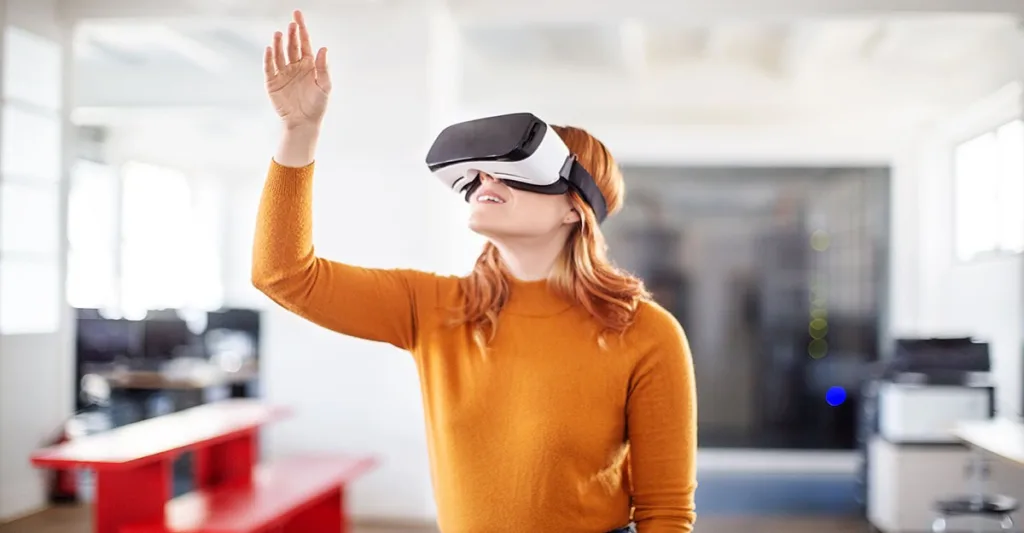Virtual reality (VR) is a computer-generated, three-dimensional environment in which users can explore and even interact in a virtual "world" using special equipment such as a VR helmet or headset and hand controllers/special gloves.
VR has evolved into an interactive educational tool for pilots and an elevated source of entertainment for arcade lovers and home gamers. But one of the most laudable uses began a few decades ago -- as a tool for training healthcare professionals.
Healthcare applications

Experts who specialize in creating learning modalities for healthcare professionals say virtual reality simulations can complement digital learning modalities such as e-learning, virtual instructor-led education, and simulation-based learning, and its uses will only expand.
"The sky is the limit on what we can do with VR right now. Natural evolution is moving into this virtual reality space," said Lora Sparkman, MHA, BSN, RN, Partner in Clinical Solutions, Patient Safety and Quality at Relias, during a NurseDot podcast on virtual reality training.
Medical teams have used VR since the 1990s to work out preoperative plans and practice complex surgeries. The immersive world of VR can replicate real-life surgical scenarios in which surgical teams also learn from their missteps, anticipate complications, and practice corrective actions before they enter a surgical suite with a real patient.
Over the past couple of decades, VR also has been used to:
- Help patients with post-traumatic stress disorder
- Treat patients with severe pain from burns
- Enhance physical therapy treatment
- Improve memory and cognitive functions
- Treat patients for phobias
The use of simulation for nurse training dates to the 1960s when Resusci Anne, a medical simulator, was used to teach CPR, and Harvey, a cardiopulmonary patient simulator, was created to replicate heart conditions and teach cardiac assessment skills.
Then came SimMan in the early 2000s, which provided a realistic view of how a patient presents with certain symptoms. Virtual reality's immersive, interactive learning approach raises the bar even higher.
For nursing students, VR gives them hands-on experience with virtual patients in clinical settings and teaches them how to perform tasks such as taking patient histories, starting an IV or checking patients' blood pressure. HealthTech reported that 65% of nursing programs now use VR.
"In the last several years, nursing schools have really adopted VR and brought it into the fold of nurse training simulation," said Sparkman, who spent 10 years at the bedside and has 27 years of experience in healthcare administration and consulting, focusing on improving patient outcomes and reducing risk. "You can practice using different techniques and using medical equipment and devices in the virtual space."
Sparkman acknowledges that despite VR's obvious benefits, it's a complement to hands-on learning -- not a replacement. Student nurses still need instructors to guide them during clinicals, as new nurses will need preceptors to do the same, she said. "These nurses are better prepared for real-life care because they've practiced in a safe environment in VR and know what to expect."
Sparkman said the experiential learning in VR helps nurses learn at a much higher rate than other forms of learning. "And it also helps us retain information at a much higher rate," she said.
Benefits for nurses and student nurses
As a training and continuing education tool for nurses and student nurses, VR:
- Provides life-like experiences -- The immersive environment gives learners a more realistic sense of "being there" that carries over into real-life practice.
- Teaches empathy -- Some VR simulations allow nurses to experience what a patient might see and hear when a nurse or other provider is caring for them.
- Builds confidence and critical thinking skills -- Learners practice how to make clinical decisions, think critically, and problem solve without endangering patients.
- Results in accelerated learning and retention -- Higher retention comes, in part, with the high engagement or "fun factor" that learners enjoy. Studies have shown that "students demonstrate significantly higher knowledge gain" from VR over screen-based learning.
The soft skills component
Sparkman said that VR can be a valuable tool to grow nurses' soft skills like communication, active listening, emotional intelligence, conflict resolution, and critical thinking. It can help train nurses on how to talk to patients or their families, especially during critical situations.
"It's one of the hardest things if you've never been exposed to death and dying or really critically ill patients," she said. Helping nurses prepare to handle emotional and tough conversations and being able to give them feedback is invaluable, Sparkman said.
Nurses can also practice how they should react to a patient's changing symptoms or agitation.
One study, which focused on the effectiveness of VR in soft skills training found that VR learners:
- Were up to 275% more confident to act on what they learned after training
- Were up to four times more focused than e-learners
- Were 3.75 times more emotionally connected to the content than classroom learners and 2.3 times more connected than e-learners
Are hospitals using VR?
Although the pace at which hospitals are integrating VR into its training modes is lagging behind nursing schools, Sparkman believes it will soon be a principal component of continuing education and training for hospital interdisciplinary teams.
Similar to its use in nursing schools, part of its appeal as a training tool in the hospital setting is the engagement factor. "You can't be a passive learner with VR," she said.
Sparkman sees the potential for its use in just about any setting. When VR is used to train OB staff, for instance, VR training can teach them how to handle emergencies such as hemorrhage, hypertensive crisis, sepsis, or shoulder dystocia.
The appeal of it, said Sparkman, is also tied to how hospitals can essentially program VR simulations to incorporate standards of care to maintain the competency of clinicians in safely delivering quality care.
"Imagine that across your entire enterprise, everyone is immersed in evidence-based guideline standards," she said. "Researching and understanding VR is something we're going to dive into quite deeply with our solution, Relias OB, which is assessment-based, personalized learning with the immersive VR experience."
Part of getting hospitals interested in VR simulation technology for training is iterating the benefits for staff, but also to the hospital or health system overall.
- VR is portable and scalable -- Virtual learning can provide experiences that mimic real-life scenarios and take place anywhere with any number of learners.
- VR provides standardized learning -- Learners all get the same experience, and students can also repeat the lessons to learn the material.
- VR can help overcome inequities and promote inclusivity -- VR can provide realistic depictions of diverse patients and scenarios, so when clinicians encounter them in real life, they will be more likely to provide high-quality care to every patient consistently and objectively.
Despite these benefits, hospitals may hesitate to add VR to their educational tools due to the initial costs. Although up-front costs for adopting VR technology may be higher than more traditional modalities such as in-class instruction and e-learning, how that cost changes over time may be a factor hospitals should consider.
According to one survey that compared VR training with live exercises, initially it was more costly than the live exercises. However, "The larger initial investment in virtual reality can be spread across a large number of trainees and a longer time period with little additional cost," making it more cost-effective in the long run, according to the study.
Though hospitals may be hesitant to adopt VR training, there is no denying its promise in helping healthcare professionals hone their skills in fun, safe, realistic environments.
Is virtual reality one of your training tools? Comment below and talk to your fellow nurses about this topic. Download the Nurse.com social networking app. 






